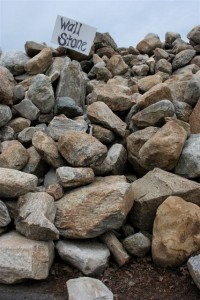I’m frequently asked if a stone pile is associated with Native American tradition, or an artifact of agricultural activity. Having been recently asked this by someone with the administrative responsibility of adjudicating this debate, I thought I’d put it in my SWI blog, and make it available to anyone interested.
First, the presence of Native horticulture turns this binary (Native vs. agricultural) into a tautology. More simply, a pile can be Native AND agricultural at the same time. Cobble piles in Native farming sites should look like those of Euro-Americans.
Second, the binary of farming vs. Native American is only one set of explanations that is logically equivalent to the set of other explanations we do know about, which is logically equivalent to the set of explanations wee do not know about. A decision about one pile must be made in the context of these three sets.
This begs the question: “What’s a stone pile?” First, it’s an unconsolidated (loose) concentration (many stones) of clast-supported (stones rest upon one another without being supported by matrix) eminence (positive topographic feature). To me, “pile” connotes a “dumped” degree of order, meaning the mass of stones are not deliberately stacked or arranged in any particular way. This leaves the possibility of surface alteration/decoration/shaping possible without disqualifying it as a pile. Depending on context, a stone pile may be no more than a few stones placed one upon the other. Or it might be a giant heap. I’m not going to define it here because you probably have a good working definition in mind. And that’s good enough for now.
The much easier question ignores these sets of possibilities and deals with one straightforward question: Is this an agricultural pile? If we turn this question into a statement that is relevant, ethical, original, and can which will yield a yes/no result is a hypothesis. By relevant I mean is it worth spending personal or societal effort on it. By ethical, I mean that it does not transcend our community standards of behavior toward one another. By original, I mean it hasn’t been done before: each new pile is an original question. By a yes/no result I mean it is one or the other. Anything fuzzier result disqualifies the statement as being a hypothesis.
Depending on circumstances, the question “Is it an agricultural pile” can be tested within certain limitations in the New England woodlands.
UTILITY AND EXPEDIENCE
The most important and useful limitation is the assumption of “utility and expedience” in the context of making a living from the land with Euro-American agriculture practices involving mixed husbandry: pasture/ tillage/ sugar-bush/ woodlot etc. during what I call the “pioneering” and “established farm stage.” Humans have limited agro-ecological resources and do not do things like building piles either frivolously or “just for the heck of it,” which I call the idiosyncratic function.
Making the utility-expedience assumption requires that stones were piled to dispose of a local excess of stone, and that local excess was not needed to serve as a source of stone elsewhere. If this were the case, and if the stones were uniformly distributed, then so too should be the piles. Furthermore, the spacing and mass of the piles should correlate with the stoniness of the land.
Outcrops, slabs of rock, residual stumps, ravines, swamps, fence-lines, are sites where neither pasture grass nor crops can grow. Hence, they are preempted from productive activity. They will absorb waste stone if they are close enough to the source. In fact, sprawling stone piles on slabs of rock and outcrops are diagnostic of agricultural waste disposal, and will be used before piles are built on non-preempted land.
Utility-expedience requires that the stone in a pile is not carefully places. It can be placed to economize space, but will not carefully so.
Piles grow outward like talus cones. Along any ray, they are concentric. Any variation in the stone coming at the pile will manifest as “vertical” stratigraphy. A dumped load(s) is suggested by a more massive texture (with exceptions). Dumping, however, usually imparts an asymmetry in plan (like a fan) and cross-section (like a snow-drift with the steep side nearest the site of dumping).
COMPARING PILES
An independent test involves comparing the spatial pattern and morphology of known agricultural piles to those of unknowns. The simplest association here is that waste piles are usually plural, and seldom singular. Let’s not forget that waste piles were harvested to create stone walls. Hence, it’s hard to assume that the resulting pattern is the whole original pattern.
OCCAM’S RAZOR
When presented with two explanations for one phenomenon, the most likely to be correct (not the same as being correct) explanation is the simplest one. What this means is that a stone pile in the woodlands can be assumed to be an agricultural pile unless proven otherwise, because this is the simplest explanation.
